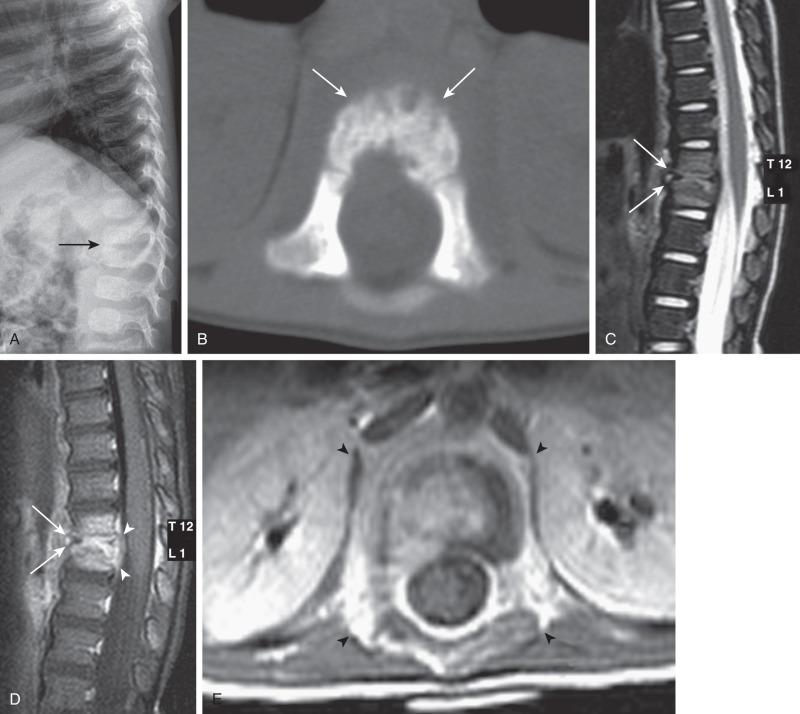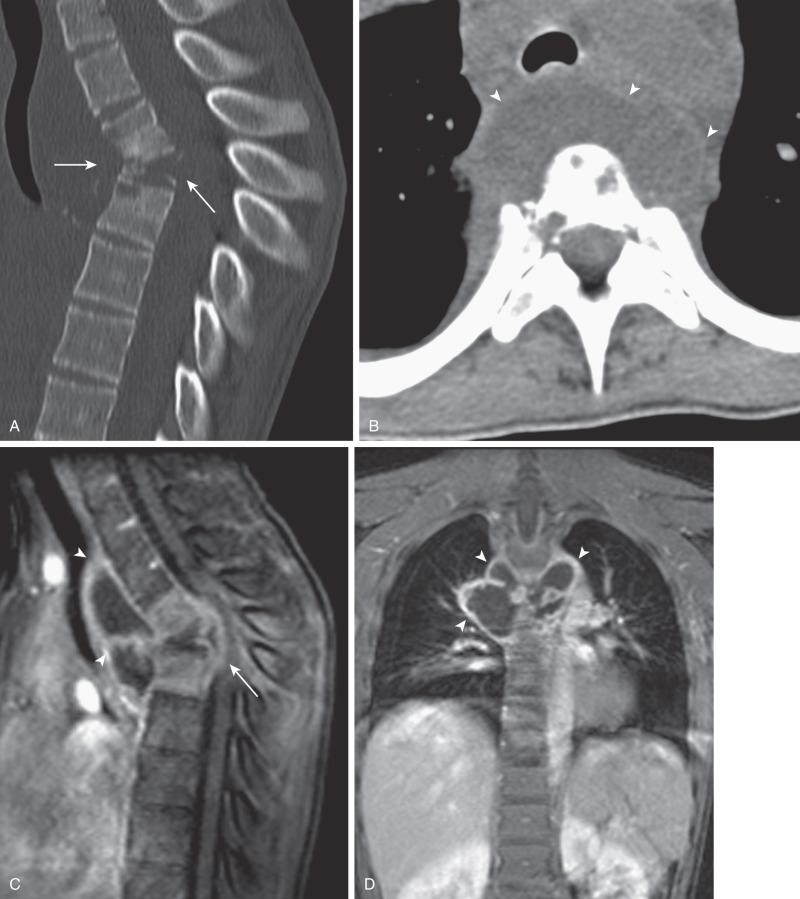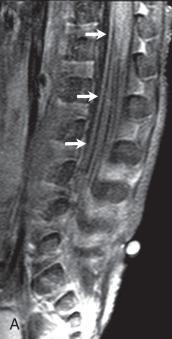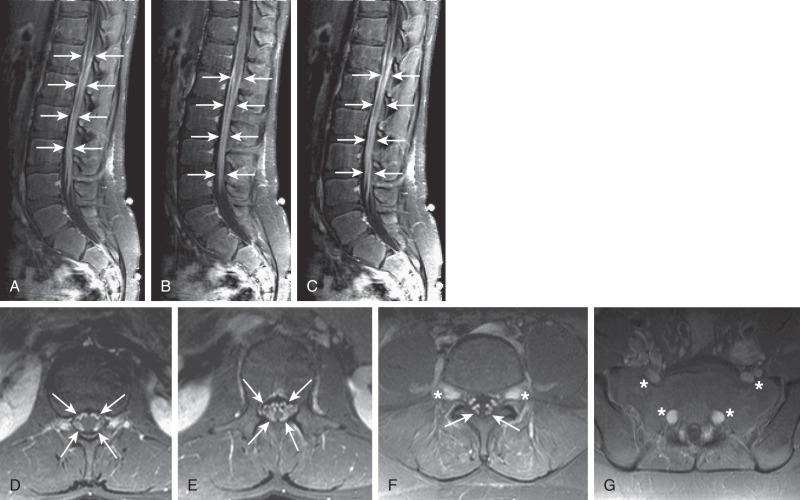Physical Address
304 North Cardinal St.
Dorchester Center, MA 02124
Spinal infections in children occur uncommonly. Etiologies include direct and indirect (hematogenous) inoculation by bacterial, viral, parasitic, and fungal agents. Direct bacterial infectious inoculation may be as a result of trauma, instrumentation, or via a preexisting congenital sinus tract or area of spinal dysraphism (i.e., meningocele). Lyme disease ( Fig. 44.1 ), caused by a Borrelia burgdorferi -infected tick bite, is also a cause of spinal cord infection, especially in the Northeastern United States. Mosquito-borne West Nile virus ( e-Fig. 44.2 ), with cases initially appearing along the east coast of the US, has emerged as an infectious cause of spinal cord infection. Enterovirus D68 ( Fig. 44.3 ) is a respiratory illness that has been recently described to be a cause of spinal cord infection, which can result in acute flaccid paralysis. Tuberculosis (TB) ( Fig. 44.4 ) of the spinal cord usually occurs in the thoracic region in children and manifests as an intramedullary tuberculoma, most often seen in patients with AIDS or other immunocompromised states. TB is most prevalent in India but is also widespread in Africa and Southeast Asia. Cysticercosis ( e-Fig. 44.5 ) is the most common parasitic infection encountered within the spinal cord. It occurs after ingestion of uncooked pork infected with Taenia solium and is most prevalent in South America and Southeast Asia. The parasitic infection Gnatosthomasis ( e-Fig. 44.6 ), caused by the nematode Gnathostoma spinigerum , can lead to the clinical presentation of myeloradiculitis. Acquired by ingesting contaminated fish or meat, it is endemic in Southeast Asia and is virtually unknown in North America, other than in cases acquired abroad.
Inflammatory entities, related in some form to infections, are often how spinal cord infections manifest. Neurologic deficits often prompt imaging in the search for a diagnostic explanation for the patient's symptoms. Magnetic resonance imaging (MRI) remains the gold standard examination for the evaluation of spinal cord infection. In general, central nervous system infections present with hyperintensity on fluid-sensitive T2-weighed sequences, and with variable enhancement on gadolinium-enhanced T1-weighted sequences. Like infections elsewhere, increase in cord caliber often occurs secondary to an increase in water content/edema. Rare related hemorrhages can at times be more clearly seen using gradient echo sequences.
Disc space infection often coexists with vertebral osteomyelitis in children secondary to hematogenous spread, through capillary tufts in vertebral body endplates, and vascular channels of immature intervertebral disc spaces. Contrast-enhanced MRI is the study of choice and should be performed without delay in suspected cases ( Fig. 44.7 ). While infection can occur at any level, the midlumbar spine is most often affected. Staphylococcus aureus represents the most common etiologic organism. Worldwide, atypical etiologic organisms such as TB are not uncommon. The first radiographic sign of infection is irregularity of the vertebral body endplates. The affected disc space is most often narrowed and demonstrates low signal intensity on T2-weighted sequences. Edema and postcontrast enhancement in adjacent vertebral body endplates indicate the presence of associated osteomyelitis and possible disc space abscess. Complicated cases demonstrate epidural/paravertebral abscess/phlegmon, which are well seen on MRI. Signs of late detection include vertebral body collapse and spinal deformity ( Fig. 44.8 ). After treatment, vertebral body and disc space findings may persist for up to 24 and 34 months, respectively. Chronic recurrent multifocal osteomyelitis (CRMO) is the most severe form of chronic nonbacterial osteomyelitis. The etiology remains unknown, and it is a diagnosis of exclusion. Although CRMO most commonly affects the metaphyses of long bones and medial clavicles, vertebral column and pelvic involvement is relatively common ( Fig. 44.9 ).



Since the eradication of poliomyelitis, Guillain-Barré syndrome (GBS), or acute inflammatory demyelinating polyradiculoneuropathy has become the most common cause of acute motor paralysis in children. It is believed to arise from an abnormal T-cell response precipitated by a preceding infection. Infectious etiologies include Epstein-Barr virus, cytomegalovirus, hepatitis, varicella, Mycoplasma pneumonia , and Campylobacter jejuni . MRI of the spinal axis in patients with GBS often shows thickening of the cauda equina and intrathecal nerve roots as well as anterior predominant nerve root gadolinium enhancement, even beyond the time period of the initial presentation ( Fig. 44.10 ). Imaging findings have been described to be 83% sensitive for acute GBS and are present in 95% of typical cases. Chronic inflammatory demyelinating polyneuropathy (CIDP) ( e-Fig. 44.11 ) is thought to be a chronic form of GBS that shares similar imaging characteristics but often shows marked nerve root thickening.


Become a Clinical Tree membership for Full access and enjoy Unlimited articles
If you are a member. Log in here